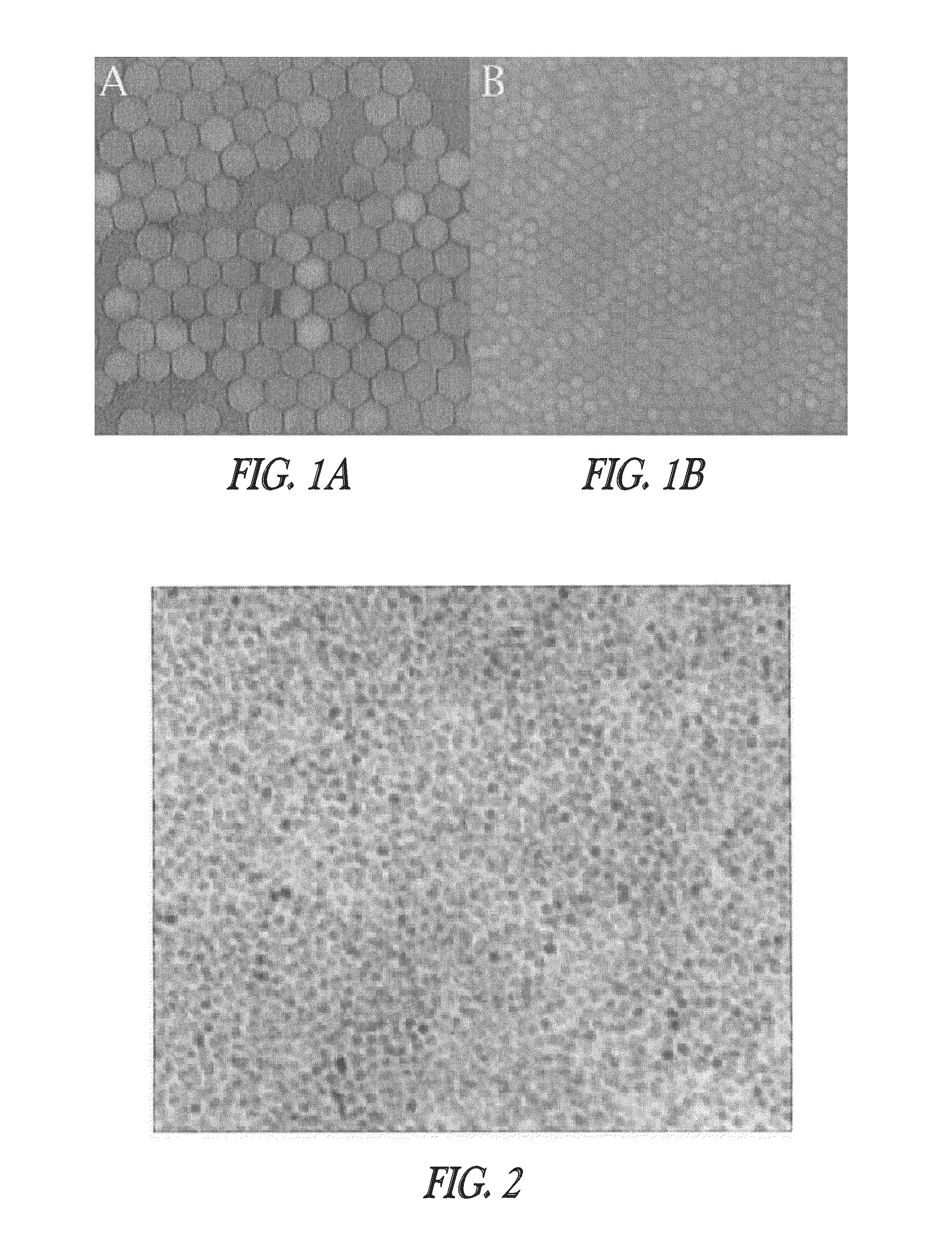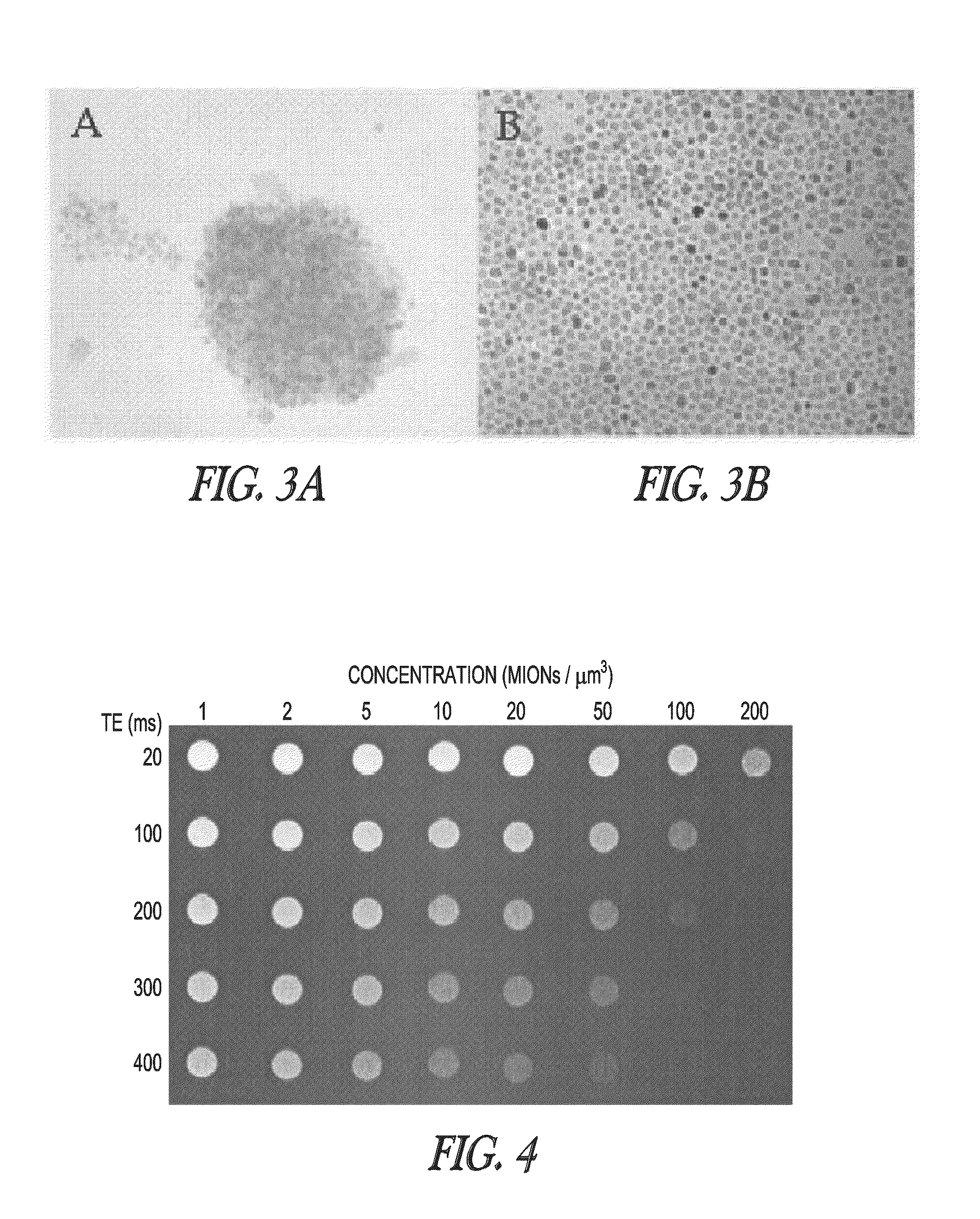Synthesis and conjugation of iron oxide nanoparticles to antibodies for targeting specific cells using fluorescence and mr imaging techniques
a technology of fluorescence and mr imaging, which is applied in the preparation of sugar derivatives, peptides, dispersion delivery, etc., can solve the problems of large size of dextran coating, high purification level, and potential immune reaction triggered
- Summary
- Abstract
- Description
- Claims
- Application Information
AI Technical Summary
Benefits of technology
Problems solved by technology
Method used
Image
Examples
example 1
Synthesis and Characterization of Water-Soluble Maghemite, •-Fe2O3 Nanoparticles.
Synthesis of Maghemite, γ-Fe2O3 Nanoparticles Articles
[0077]The iron oxide particles were synthesized using a method slightly modified from the Hyeon method. A solution of 3 mL (9.45 mmols) oleic acid (OA) and 15 mL (34.31 mmols) trioctylamine (TOA) was heated to 320° C. under an atmosphere of nitrogen. Once the solution reached a temperature of 200° C., 0.4 mL (3.04 mmols) iron pentacarbonyl (Fe(CO)5) from Sigma Aldrich was injected. As the solution was heated at 320° C. for 1 hr, the color of the solution changed from its initial postinjection color of orange to clear as the iron pentacarbonyl decomposed to Fe ions. The solution then turned to an opaque black as partially oxidized Fe / FeO nanoparticles formed. During a successful synthesis, the change from clear to a translucent brown is gradual, followed by a rapid change to opaque black. After 1 hr, the solution was cooled to below 60° C. and then 0....
example 2
Preparation of Antibody Conjugated, Phospholipid Coated •-Fe2O3 Iron Oxide Nanoparticles
Synthesis of the γ-Fe2O3 Nanoparticles
[0107]The nanoparticles are synthesized from an iron pentacarbonyl precursor using the Hyeon method. 15 Ml trioctylamine (34.31 mmol) and 3 Ml oleic acid (9.45 mmol) are heated to about 200° C. under an atmosphere of nitrogen. Once the solution has leveled off at 200° C., 0.4 Ml Fe(CO)5 (3.04 mmol) is injected and heated to reflux (about 310° C.). Nucleation occurs during heating between about 310° C. and about 330° C. As the iron pentacarbonyl decomposes into Fe ions, the solution transforms from a transparent, bright orange to clear. After approximately 1 hr. of heating, the solution rapidly turns from clear to an opaque black indicating the start of nucleation of Fe / FeO nanoparticles. Once the nucleation begins, one continues heating the solution for 5 to 15 minutes depending on the size of nanoparticles desired. The solution is then cooled to 130° C. and ...
PUM
| Property | Measurement | Unit |
|---|---|---|
| temperature | aaaaa | aaaaa |
| temperature | aaaaa | aaaaa |
| temperature | aaaaa | aaaaa |
Abstract
Description
Claims
Application Information
 Login to View More
Login to View More - R&D
- Intellectual Property
- Life Sciences
- Materials
- Tech Scout
- Unparalleled Data Quality
- Higher Quality Content
- 60% Fewer Hallucinations
Browse by: Latest US Patents, China's latest patents, Technical Efficacy Thesaurus, Application Domain, Technology Topic, Popular Technical Reports.
© 2025 PatSnap. All rights reserved.Legal|Privacy policy|Modern Slavery Act Transparency Statement|Sitemap|About US| Contact US: help@patsnap.com



